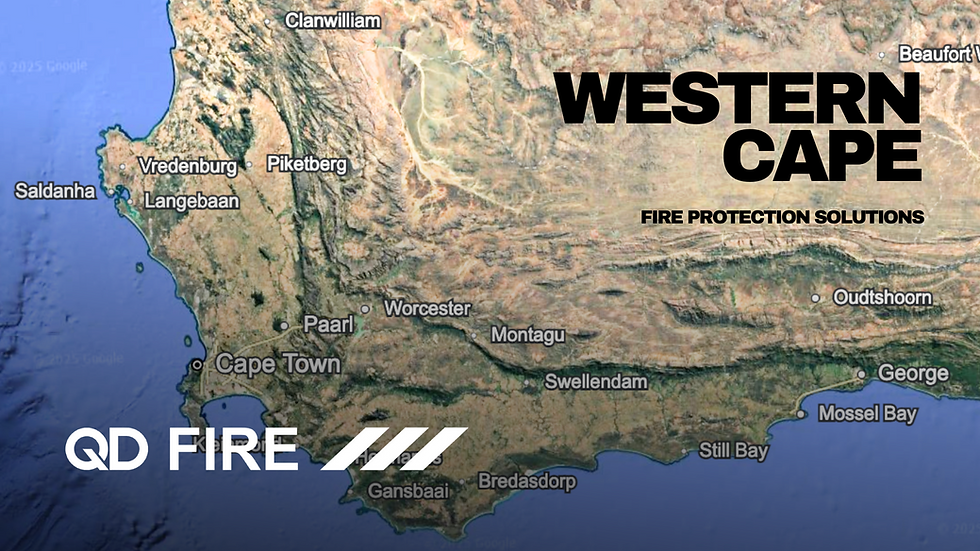Shopping Centre Fire Sprinkler Systems
- qdfirecapetown
- Aug 1
- 3 min read

Fire Sprinkler Systems in Shopping Malls: Prioritising High-Risk Design
Shopping malls are complex environments with diverse tenants, each presenting unique fire risks. Designing an effective fire sprinkler system for a mall requires careful consideration of these risks, with the highest risk dictating the system’s design and hydraulic requirements. This blog post explores the importance of prioritising the highest fire risk, the impact of tenant-specific hazards, and the solutions required when municipal water supplies fall short.
The Importance of Prioritising the Highest Risk
In fire protection engineering, the highest risk takes precedence over all others. This principle ensures that the fire sprinkler system is robust enough to handle the most severe fire scenario within the mall.
The highest risk determines critical factors such as:
Design Density: The rate at which water is discharged over a specific area (measured in mm/min/square meter).
Hydraulic Requirements: The water flow and pressure needed to suppress a fire effectively.
By catering to the highest risk first, the system can adequately protect the entire facility, including areas with lower risk profiles. Failing to address the most severe hazard could result in an under-designed system, incapable of controlling a fire in critical areas.
Tenant-Specific Risks in Shopping Malls
Shopping malls host a variety of tenants, each contributing to the overall fire risk profile.
Common tenant types include:
Food Stores: These may store combustible materials like packaging or cooking oils, presenting moderate fire risks.
Hardware Stores: These often stock flammable liquids, paints, or timber, increasing the fire load.
Plastic Commodity Stores: These pose the highest fire risk due to the presence of unexpanded and expanded plastics, which create a very high fire load.
Plastic commodity stores are particularly hazardous because plastics burn intensely and release significant heat, leading to rapid fire spread. The high fire load from these materials demands a sprinkler system with greater water discharge rates and specialised design considerations, such as high-hazard classification under standards like NFPA 13 or ASIB 12th Edition 2024.
Hydraulic Requirements and Water Supply Challenges
Once the highest risk (e.g., a plastic commodity store) is identified, the sprinkler system’s hydraulic requirements are calculated based on the design density and area of coverage. However, the local council water supply may not always meet these demands. Common issues include insufficient flow rate or pressure, especially in areas with aging infrastructure or high demand.
When the municipal water supply is inadequate, additional measures are necessary:
Fire Pumps: These boost water pressure and flow to meet the system’s hydraulic needs. Electric or Diesel-driven pumps are typically installed to ensure reliability during power outages.

Fire Water Storage Tanks: On-site tanks provide a dedicated water reserve, ensuring the sprinkler system can operate for the required duration (e.g., 60–90 minutes, depending on local codes).

These components add complexity and cost to the system but are critical for ensuring compliance with fire safety standards and protecting lives and property.
Designing for Safety and Compliance
To design an effective fire sprinkler system for a shopping mall, engineers must:
Conduct a thorough risk assessment, identifying the highest fire risk among tenants.
Calculate the design density and hydraulic requirements based on this risk.
Evaluate the council water supply to determine if it meets the system’s needs.
Incorporate fire pumps and storage tanks if the water supply is insufficient.
Ensure compliance with local and international standards, such as ASIB 12th Edition 2024, NFPA 13 or EN 12845.
Regular maintenance and testing of the sprinkler system, pumps, and tanks are also essential to ensure long-term reliability.
Fire sprinkler systems in shopping malls must be designed with the highest risk in mind, as this dictates the system’s performance requirements. Plastic commodity stores, with their high fire load, often represent the most severe hazard, necessitating robust hydraulic designs. When municipal water supplies fall short, fire pumps and storage tanks become critical components. By prioritising the highest risk and addressing water supply challenges, mall owners and engineers can create safer environments for tenants, customers, and first responders.
.png)


